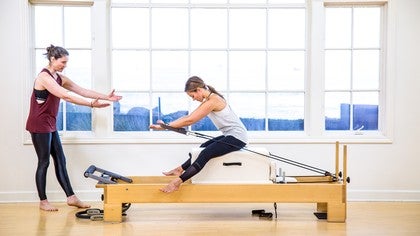Description
About This Video
Transcript
Read Full Transcript
Hi, I'm Julie Driver, and today we're doing a reformer class based around Pilates for equestrians. Clearly anybody can do it, but particularly we're going to be looking at how the reformer assists riders to deepen their seat, and deepen their relationship with their horse. So Georgina is here with me from England today, and she's gonna turn around elegantly and lie down on the reformer. We're gonna start with footwork. So the first position I would like her to assume is she's going to be in her Pilates V.
So, a little bit wider between your heels. So all she's gonna do is straighten her legs and bend, good. Just take your head to your left very slightly. So, footwork when we're working with a rider is really good because what we're looking at is their thoracic and lumbar stability. So if Georgina brings her arms up into the air.
What I particularly look at is what's happening here, so that as she's bending and straightening her legs, if when we're in the saddle if we're bending and straightening our legs for rising or posting that there shouldn't be any translation to the spine. The spine shouldn't be wiggling and jiggling around. So that's why this is a significant exercise. She's gonna lower her arms, and she's going to turn her feet to parallel, apart, hip width apart. Same thing, and again we can bring the arms up 'cause it's mimicking holding the reins, and she's gonna straighten her legs and bend.
Good, we're just gonna do a few like this, just for her to get the feel of the support of the carriage underneath her, and that when she's breathing that she can still feel that her ribcage is connected to the mat. And on the next one we're gonna make a little bit more relevant to riding. We're gonna place the arms down by the side. So she's lifted into plantar flexion, and she's gonna keep the heels lifted as she bends her knees, then I want her to simultaneously as she lowers her heels she's gonna straighten her legs. There and then she's gonna lift up onto her toes and bend the knees without dropping the heels.
Then as she lowers the heels, she's gonna straighten her legs. Lift up onto the toes, keep the heels lifted as she bends her knees. Lower the heels and straighten the legs. Now we're going to reverse it. Good, so she straightens her legs, she lifts the heels, straightens the legs, lower the heels, so now as the heels are under the bar, she's bending her knees, this is really like sitting into the saddle and dropping the heels, and again, good.
She gonna lower heels, good, and we're gonna do one more. Good, bring the carriage to rest, and we're gonna put the heels nice and wide onto the footbar. So now in this position same thing, we're just gonna straighten the legs, I don't mind how you choose to breathe, whether it's breathing in as you straighten, or breathing out as you straighten. The most significant thing, the important thing, is what's happening here, that we're not getting any movement in the ribcage as she's moving. Good, we're gonna do two more.
And then she's gonna bring the carriage to a standstill, and now she's gonna come onto her toes in this wide position. She's going to straighten her legs and lower her heels. Good, and lift, and bend. We're gonna do three more like that, simply straightening the legs, lowering the heels for wider tendon stretch, and lift, and bend, and last one. And then we take up the same pattern of movement that we had when her feet were parallel.
So she's wider now, she going to straighten. Lower the heels, bend the knees trying to keep the heels dropped, and then lift. And straighten, and lower, and bend, so this position here, as she comes in, is really great for opening the hips, getting the dorsiflexion in the heels, ankles. And now she's going to elegantly reverse it. I'm terrible with reverses.
There we go, good. So she bends, lowers the heels as she presses out simultaneously, lifts onto the toes, and bends the knees trying to keep the heels lifted. Drops the heels, good. And bend, so our last one as she's gonna straighten her legs, lower the heels, keep the heels lowered, and she's gonna bend at the hip and the knee. So the ankle will move a little as well, and then you're gonna pulse here, you're gonna go up and down, and up and down, and up and down, good.
So you can see this is like a rising trot. But all the time we're making sure that the spine is stable. So she's moving hips, ankles, knees, but not the actual spine itself. If she was riding she would be going up and down, but not. The spine wouldn't be moving at joint level, it would be moving (hands slapping) here.
Good, last one, bend the knees and come back in. Beautiful, rest your feet for a second because I'm gonna change the spring, so just for reference that was on quite a heavy spring for her footwork, and we're gonna lighten it down now 'cause we're going to use her arms. So we're going to a sort of medium weight. And I'm going to just change the handles. The comfort of my clients is always my priority.
Would you take that? As long as I give you the right one. I don't cross them over. Okay, and take this one, and you're gonna pull forward. And just pull forward, okay, good.
So now, she's moving the machine from her hands. She's gonna lift her feet off of footbar and bring them in. So again, it's this area here we're focused on, that as she moves her arms, she's just gonna do a lateral push, she's gonna pull straight down and lift the chin. Good, and up, nice and simple. What I really want Georgina to focus on is the opposition of the movement.
So as her arms are going forward, she's thinking of the spine and the head lengthening in the opposite direction, beautiful, that's it. Good, one more, so once your client, or yourself, if you're working with your own body, is capable of stabilizing here, we're gonna challenge it, we're gonna add in different arm movements, we're gonna do cheerleader, so Georgina is going to open her right arm out to the side, and she's going to pull her left arm down and her right arm in, and then she's going to change, good. So now we've added in an element of coordination, we've added in an element of larger movement and of asymmetrical movement as well, good. And one more, each side, no point giving them an asymmetrical exercise if you only do one side. Good, and arms up, so we finish with symmetry.
So now what I'd like Georgina to do is on her next out breath she's gonna curl up and we're gonna do one hundred. She gonna straighten her legs, and she's gonna start to pump her arms. Good, so she's flexed, so the pumping movement of the arm is challenging the stability of her spine in this position. So we're gonna challenge it neutral, we're challenging it flexed, and then we're gonna challenge it in extension, as well. Good, two more, and we're back as well with the feet, we're in the same position we started with.
She's gonna bend her knees in (laughs) and place her feet down. Okay, I'm changing the spring for her again, because I'm a nice teacher. I could make her teaser up and change her own springs, but I'd like her to stay my friend. And she's now gonna put the straps onto her feet. I'm not doing that for you, there we go.
Good, Georgina now has her feet in straps, and she's just gonna do some simple frog. So just gonna bend and straighten. So we're the same, working the same as we were on the footbar except now her feet are separate. Good, this is nice and easy, so what we're gonna do is we're gonna make it a little bit more challenging, and a little bit more as if there was a thoroughbred between your thighs. And we're to bend knees, and you're going to place the ring between your ankles, darling, there we go, a little bit higher, above your medial malleolus, there we go, okay, so now she's wider.
She's assumed the position of being more like in the saddle. And she's gonna straighten her legs, and bend, good. Squeeze the ring a little bit more, good, yeah. Lift your chin, good. So again, we're watching how she's managing what's going on in her spine, here.
I'd like her to bring her arms up into the air. And go wide, actually go, I think outside of the, there we go, now hold the legs here, bend them in about halfway, and really dorsiflex your feet. What I want her to do now is to just start to pulse, you're gonna go in and out, and up and down, lift the chin, good. So again, we're making this more like the rising trot. So what we need to make sure when people are riding is that they don't create their rising trot simply by pushing down into the heels and levering themselves up out of the saddle.
There should be the movement we've got here. It should be a movement of their own body. They're supporting and using their own body. They're taking responsibility for their own torso and for their own limbs, good. How are you doing? Awesome.
Straighten your legs, (laughs) and I shall free you from the circle, good. And bend the knees in, and rest. Good, okay, now we're gonna do some circles. We've removed the circle to do some circles, good. This is just again, it's just opening the front of the hips, using the back of the leg, good.
And when you're ready you can reverse. Good. And when you're ready, you can stop. Bend the knees in, and take the straps off. Okay, so Georgina is now going to sit up on the reformer, and she's going to face the footbar.
We're going to drop the spring down for front rowing. So we've done lots of work with her lying on the mat, focusing on the upper body and the stability of the thoracic spine, now we're sitting her up. I'll take the footbar down, one red, yeah, that's fine. Can you move your feet, please? Okay. So, she's going to take the straps.
You okay with those straps, or would you prefer the handles? Okay, so, what we're doing now is we've taken her from lying down, we'll have that lovely feedback for her spine. Now we're asking her if she's able to manage this as she moves her arms and legs, as she moves only her arms, we're not moving your legs. So from here you're gonna straighten your arms up, good. You're gonna lower the arms to tuck the carriage.
You're gonna lift the arms to the ceiling, and you're gonna circle, good. And again, she's gonna reach forward, now stay here, I really want you to feel that as you reach forward that you're connected into the back of the ribcage. Now as you tuck the carriage think of the axial elongation as you reach up, good, and reach up again, and circle, good. And again, and tap the carriage, and reach up, and circle. Good, now she's gonna cross her legs, and we're gonna shave the head, okay.
So we've brought her to a diagonal. Can you just up a little, there we go, okay. So now straighten the arms without moving your spine, and bend, good. So we've simply pitched her forward onto a slight diagonal to see if she can manage her spine here again when she moves her arms. Good, we're gonna do one more.
And then as she comes to open her arms out, she's gonna come to sitting for hug. And again, close the arms and open. We're gonna do two more. And the next time the arms come together, I want her to turn her palms in, and just bring her hands underneath her. So now we're more in a classical holding the reins position.
So from here, all I want her to do is to straighten her arms and come back in, good. Great, just one more. And then you'd hang the straps behind you. And we're gonna put the box on. So for the first exercise, I'm keeping the spring loading the same, I'm not changing it.
Okay, so the first exercise I want Georgina to do, she's going to sit on the box facing the risers. If you find your client has difficulty sitting here with a straight back, then you can allow them to have their feet off the headrest, otherwise the feet on the headrest is the best position. She's going to take the straps, and hold them, so the brilliant thing about the reformer is you have a moving surface to simulate what's happening when they're riding, and you have the straps. So all I want Georgina to do, the moment she's holding her arms here, is she's simply gonna pull the arms back in to that riding where we're holding our reins, and then she's gonna let them go forward, good. So I think of this a little bit like the give and take you have with the reins that we're allowing communication whatever needs to happen with the upper body, without it having to translate into the spine and a shift of weight in the saddle.
We're gonna do one more. And the other thing that's great about Pilates for riders, as well, is it's inevitable that at some point you are going to be shifted in the saddle. It's about how you can re-find the balance and your correct posture when you're in the saddle. Can you hang the straps back on? Georgina is going to step off the machine and come back onto her tummy because we're going to do pulling ropes.
So now we're challenging her spine in extension. So she's going to curve her body forward and take hold of the ropes. Just gonna check her alignment, okay, so. At the moment she's flexed forward. What I would like her to do is to start to lift the head and pull the ropes, good.
Now she's gonna stay up and she's gonna bend her elbows. Good, and then straighten her arms. So this is very similar to what we were just doing, but now she's in an extended spine position. So we're building some stamina in there as well. Good, one more, not that you ride round in extend, well you might ride round in extension, that would be bad.
Okay, now I'm going to make this an asymmetrical exercise. I'm gonna drop the weight for her, so I'm halving the springs, so whatever spring load you're working on just halve it. And she's going to hang her right strap back on and hold onto her left strap, so all she's gonna do now is come up and pull on the rope. And as she pulls her left arm back, her right arm is going to go forward, and then back, good. And again, so she's gonna extend and pull on the rope.
And down, and we're just gonna do one more. Good. And she's going to switch arms. Good. So what we're looking for is, if as she pulls is there any rotation, if she laterally flexes, as she pulls on the rope hopefully her spine should stay extended.
And there shouldn't be any deviation left, right, rotational, either, good. Now, she gonna come back down, hold the rope with both hands. I'm gonna change the weight again. So I'm now putting it back up because I want to finish with symmetry. I don't want to finish the exercise asymmetrically, and she's gonna do two more pulling ropes working symmetrically this time.
Good. It's always a good idea to finish a section with symmetry. And down, good. Georgina's gonna hang the straps, and she's going to step off to one side. So Georgina is going to mount her steed for horseback.
Okay, so, come a little bit further forward, okay. So she's starting in this position, so it's similar position we've been working with. Now, I want her to start with a vertical spine, so come back a little, there, so what I want her to find is that as she reaches her limbs forward, she's gonna take her spine backwards into that space, and you're gonna reach down to the footbar, and lift up and over that spring. I want to see air under your butt, there, and then back in, good, and again. Lift, lift, lift, reach down, there, good.
And again. So almost think of trying to lift yourself up and over the tension of the spring, and back down. We're gonna come up again because we're gonna challenge the shape. We're gonna challenge her spinal flexion. She's gonna come back up, so I need her to hold her spine flexed a little more, lift your ribs up into your spine, there, and circle.
Hands a little higher, one, two, three, and then she's gonna reverse, one, two, tuck your bum underneath you a little bit more, there. Yeah, so you need to find that precarious balance point. That's the one we're looking for (laughs), and step off to one side. Good, and we're gonna take the box off. So we're going to do down stretch.
So footbar goes back up, and I'm putting, for balance body people, I've got a blue and a red. And so it's a sort of medium spring. And you are going to mount your reformer. Down stretch. Down stretch, okay.
So this is really great for checking on people's dorsiflexion, if you need to pad them then help them with that because if they can't feel the heel against the headrest then we're losing some of that element of connection there into the machine. Just turn this leg out a little bit more, there we go. So, without moving the machine, I want Georgina to extend her hips and lift her spine, good. A little bit more extension from here. Good, now she's gonna press the carriage out, and then come back in and lift her chest to the ceiling, good.
So now, again, just like in pulling rope she's in extension and we're challenging her, you can go further out in that. Go, go, go, go, go, go, go, and then lift. One more. Good, she's gonna bring the carriage all the way in. I'm gonna put the headrest up for her, and she's going to do to long stretch.
Okay, so bring your body over the footbar more, more, more, more, more, more, good. And now she's gonna press out. Big scapula stability challenge. Good. One more.
And now she's gonna bend her knees for knee stretches. So again, we're back in this position. First thing I'm gonna do, I'm gonna ask Georgina to do the first ones flat back. So she's gonna press out, now come back in. So really, really observe what happens here when they press out, what you need to make sure is that they stay connected.
So now, she's gonna press the machine out, and she's gonna pull it in, without moving here, ideally that's what we're looking for. Good, so I'm gonna make her control it, I'm gonna make her make it smaller, so, in. So this is like she's riding, she's going up and down, and up and down, and up and down, good, stay connected. Good, one more. Then she's gonna come back in, and she's gonna round her spine.
And she's gonna do the same thing. Clearly we don't ride with a rounded spine. The idea of the exercise is to make sure to insure you don't ride with a rounded spine. But the idea of doing this exercise is so that you can feel the flexion of the spine against the movement of the legs. Good, and up.
Last one. Good, let the carriage come all the way in. Good, now our last few things, I'm going to give Georgina a sticky mat for her bum. A stomach massage, go a little bit nearer, there we go. So the springs are being changed again, and I'm going two red, for sort of medium weight.
And I'm springing the machine from the outside, so that the springs are balanced. She's going to place her feet up on the bar. I'm gonna let her get away with doing that, pulling the machine out (laughs). It's so close to the front (laughs). Well you're supposed to be, so we're back in the footwork, so in the footwork, she was lying down, she had her back supported, and now we've made her vertical, so now we've gone from footwork, rowing, kneeling, and now we're looking at the same kind of thing here.
So that she's moving her feet and legs while stabilizing her spine, so straighten your legs, lower your heels, lift, good, and come back in, good. Okay, so I'm gonna make her do it again, I want you to straighten your legs, now the idea here is as she lowers her heels, I want her to almost pull her spine back even more so she's really, yeah, now lift, now keep the heels here, and bend, and bend, and bend, and bend, don't let them drop. Yes, and again, and lower, and lift, good, okay. Now we're gonna bring her spine to vertical, she's gonna lift her arms, she gonna circle them round. Well you could have done it like that and beautiful, yeah.
(laughs) Same thing, so she's gonna straighten, lower and lift, and pull back in, good. So we're not reinventing the wheel. All we're doing is giving you an idea of how to make these exercises specific for riders, so that when you're talking to them, you're using their language, and that you're understanding exactly what the demand of their specific sport is, good. So she's gonna come back in, I'm gonna be a little bit kind, and I'm gonna just drop the spring a little, because she's been holding the machine with four limbs, she's had both of her hands and both of her feet. And we're gonna free your hands.
Give me your hands, okay. And now she's gonna work here, no lift and lower, just in and out, good. Lift the chest, good. Last one. And relax, you can place your feet down on the footbar, good, okay, and jump off.
And let's get rid of your mat, okay, so. Jump back on. Yeah, I shortchanged you, I didn't give you the stretch. It's wrong, it's so wrong. It's not, so we're gonna put the feet back on.
She's gonna do one more with the arms up. You're gonna straighten her legs. And she's gonna come back in, and this time place her hands on the footbar, so we're mimicking the Cadillac here. She's gonna part her feet to hip width. She's gonna press out, and lower her heels.
So we're mimicking monkey, just so she gets this dorsiflexion as well. Good, and you can bend, just do two more, just in and out. Good, and one more. Okay, and come back in, and you're gonna step off the machine. So now we're gonna challenge her again, by bringing her up onto her knees, we're gonna chest expansion and thigh stretch.
So I'm dropping the spring load, I'm taking the mat off, and she's going to kneel. So chest expansion first. So again, she's gone from lying down with all the support under her back, she's gone to sitting, she's been in all these different positions, and now we're challenging her vertically which is exactly where we need her to be when she's riding. So, from here all she's gonna do is pull back, turn the head to the left, turn the head to the right, and come back to the center, and again. When she was lying on her back we talked about the opposition and the axial elongation so here as she pulls back I want to think of her spine growing taller, good.
Good, and last one. Now, I'm gonna challenge Georgina a little bit more, because I actually want her to press her hips a little bit more forward, that's backwards, forwards. Find your balance point, find that precarious balance, there, now pull, yep. She just wasn't quite open enough at the hip, there. Can you feel your butt more? Good.
And let's just do one more. Good. So now we're going to do thigh stretch. Every rider needs a thigh stretch, okay. So I'm gonna suggest you put your hands through the loops, and hold where you feel that you are secure.
So now, we don't want this angle to change, the angle that's changing is the angle of the knee. So she's gonna simply think of pivoting back from her knee, good, and then up, and again. The issue we have with this exercise is people go a bit wild and they go whoo, I can get all the way back, but then they find they can't get up, and that's the problem, so you just need to just be a little bit more conservative with their range to start with. Good, and then up. And last one.
And lean, good. And back up, okay, let the carriage come to a standstill, you can hang the straps back on. And we are going to do side splits. So, I'm dropping the spring, so it's light, so I'd like you to step onto the nonmoving part first and I want you a good distance away on the actual reformer, okay. Further apart, please, yeah.
So the first job, I've made it really light, because I want her to work in the inside, open your arms up. So think of how we just got you to really open your hips for thigh stretch, work here, more, press your hips forward more, there. So Georgina's first job is to hold the machine still, I don't want that carriage to move away from the stop, and I want her to hold it for a count of three. I counted in my head, now she can press out. Good, and in, and I want her to come all the way in, good.
And out. And again, all the way in, we're gonna do one more. And then she's going to dismount. And walk round (laughs). Same thing.
A little bit wider, so you almost want them to step into the footprint of the foot they took off. And again, hold the machine and bring it in, bring it in, in, and you're gonna hold it, for one, two, three, and now she's gonna press out. This is where you really start to see the asymmetries. Yeah, good, and again, open this hip more, there you go. Let's do one extra on this side, good.
And then she's gonna pull the carriage back in and she's gonna hold it. And then carefully step off the machine. I'm gonna put the footbar up for her, she's gonna lie back down on her back, and we're gonna finish with pelvic lift, and a little bit of running. Okay, so, come a little bit wider. I'm gonna get her to do it with her arms in the air.
And I really want to make sure that she's working from here, working from underneath, working from the back of the hip. So without moving the machine I would like her to just lift her bottom off the mat, there. And then I want her to straighten and bend her legs, good, and back in, I want you to keep it smaller because I want to make it more like a rising trot, so just bounce, yeah, good, there we go, and one more. And then she's gonna come back and she's gonna roll her spine all the way back to the mat. And this time she's not going to articulate her spine.
I just want her to simply lift, just lift, boop, there, and now, out, in, out, good. One more, and then she's gonna place her spine back down. Good, she's gonna relax her arms, come onto her toes in parallel. Then she's gonna finish with a little bit of running, good. So what we've looked at is how we are able to disassociate the hips, the thighs from the pelvis while we're moving.
Scapula stability while we're moving the spine as well. And simply moving the spine. And you can bring the legs back in, and relax. So I hope you've enjoyed the class, I hope it's given you an idea of how to make the apparatus relevant to your client and their sport, and to simply enjoy teaching your client.
Pilates for Athletes: Pilates for Equestrians
Comments
Thanks again!!
You need to be a subscriber to post a comment.
Please Log In or Create an Account to start your free trial.
























